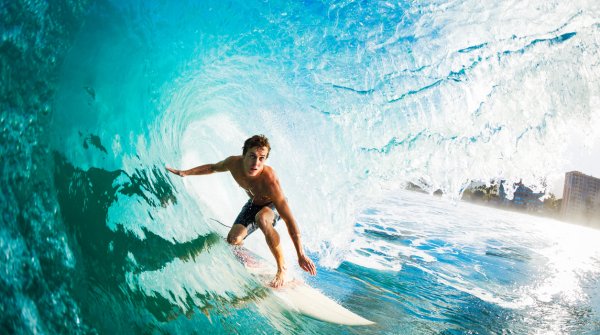
Cycling in the great outdoors or sweating it out in the gym? For many fitness freaks, it's not a question at all: They swing themselves onto the spinning bike and off they go. But why? First of all, bad weather conditions certainly come to mind. Who would enjoy getting out on the bike in sleet showers or black ice? The risk of injury increases significantly, snow or ice make progress more difficult.
A structured training with interval or repetition methods is actually out of the question. So it can be quickly clarified: Especially in winter, indoor cycling is a sensible alternative. However, that alone cannot be it, because the bikes are well occupied even in imperial weather.
Spinning means much more than cycling: For example, there is the aspect of motivation. Spinning usually takes place in classes - so you train in company. A group dynamic is formed.
After a hard day at work, the resolution to cycle around the block may be quickly forgotten. If, on the other hand, training colleagues and trainers are constantly asking questions, many think twice about skipping their course. Sport at fixed training times: an important point for overcoming the inner pig and continuously proving stamina and staying fit.
It is also motivating to do sport in the company of others - and not just to make social contacts. Ideally, a group dynamic develops after just a few training sessions together, motivating each individual to pedal a little harder and get everything out of their bike. You push each other, because after all, you want to present your fitness on the bike in front of your teammates.
The presence of the so-called instructor also has a positive effect. As a rule, spinning courses take place under the supervision and guidance of an experienced trainer, who additionally spurs on his course participants and drives them to peak performance. During the training sessions, music is played to the rhythm of which cycling can be done - pedaling to the beat: this not only gives a portion of extra power, but also makes the endurance training more varied.
Last but not least, the design of the spinning bikes ensures that you don't let your legs dangle so quickly. There is no idling here. The modern spinning bike is equipped with the so-called rigid barrel, which today is only found in track cycling or with certain artistic cyclists.
While in the early days of cycling all bikes were equipped with the fixed gear, the more comfortable idle gear has become more and more popular. So unlike the modern road bike, you can't take a short break when spinning.
However, caution is advised, especially during more intensive phases in which standing pedaling is frequent. Even if the legs give way - pedals and flywheel continue to rotate. Just like the motto: If you pause, you fly.
If you're now starting to feel anxious, rest assured: as in any sport, newcomers to spinning are carefully and systematically prepared for higher speeds. In addition, although the rhythm and intensity are set by the trainer, the resistance to be overcome can be adjusted by everyone individually.
And rigid spinning has further advantages: The flywheel, which weighs up to 30 kilograms and drives the pedals, results in a very fluid transmission. This in turn results in a very harmonious riding experience - similar to riding a normal bike.
Especially for ambitious athletes like triathletes, but also for newcomers, spinning is therefore the ideal variant. You almost automatically develop a feeling for certain cadence and are thus optimally prepared for riding on the road.
Another highly significant characteristic for cyclists is trained specifically in spinning - the "round pedal". The round kick primarily describes the angle of the force applied to the pedals. Many amateur cyclists only pedal from top to bottom, whereby a large part of the force is lost unused. This is because force can also be applied in the so-called pull phase, i.e. during the upward movement of the pedals.
With circular pedaling, there is a constant alternation of push and pull, so that the force can act evenly on the pedals and flywheel - one's own pedaling power is optimally utilized. Thus, at each point of the circular pedaling motion, there is an application of force.
This technique is implemented, both on the road bike and on the spinning bike, with the help of clipless pedals or loops that enable "pulling up". Particularly through the heavy flywheel, the round pedaling is excellently simulated, as the athlete's legs are guided in a certain way and accustomed to the movement pattern.
With all the above advantages: Spinning is not a complete substitute for training with a normal bike. Due to the lack of shifting the center of gravity, as it occurs for example in curves, the coordinative skills are neglected. Thus, balance as well as orientation and reaction skills are not trained during indoor cycling.
Nevertheless, for all those who still want to get started with cycling this coming winter, indoor cycling is the perfect training to get a feel for riding on the road. To increase your general fitness and endurance in a communal atmosphere and lose a few pounds along the way, it's well worth going to your nearest spinning class.
 Know-HowThe 11 Best TRX Exercises
Know-HowThe 11 Best TRX Exercises
- Awards
- Mountain sports
- Bike
- Fitness
- Health
- ISPO Munich
- Running
- Brands
- Sustainability
- Olympia
- OutDoor
- Promotion
- Sports Business
- Textrends
- Triathlon
- Water sports
- Winter sports
- eSports
- SportsTech
- OutDoor by ISPO
- Heroes
- Transformation
- Sport Fashion
- Urban Culture
- Challenges of a CEO
- Trade fairs
- Sports
- Find the Balance
- Product reviews
- Newsletter Exclusive Area
- Magazine



